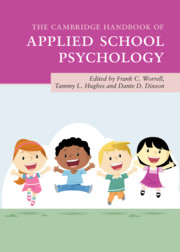Book contents
- The Cambridge Handbook of Applied School Psychology
- The Cambridge Handbook of Applied School Psychology
- Copyright page
- Contents
- Contributors
- Contributor Biographies
- Acknowledgments
- 1 Broadening the Focus of School Psychology Practice
- Part I Individual-Level Academic Interventions
- Part II Teacher- and System-Level Interventions
- Part III Interventions from Educational and Social/Personality Psychology
- Part IV Behavioral and Social-Emotional Interventions
- 19 Internalizing Problems and Disorders of Childhood
- 20 Adolescent Suicidal Behavior in Schools: What to Know and What to Do
- 21 Emotional Disturbance versus Social Maladjustment
- 22 Autism Spectrum Disorder and Illegal Acts
- 23 Effective Bullying Prevention and Intervention Strategies for School Professionals
- 24 Principles of Prevention and Intervention to Close Discipline Gaps in Schools
- 25 Social and Emotional Learning in Schools
- Part V Health and Pediatric Interventions
- Part VI Family Connections and Life Transitions
- Part VII Special Populations
- Part VIII Conclusion
- Index
- References
21 - Emotional Disturbance versus Social Maladjustment
from Part IV - Behavioral and Social-Emotional Interventions
Published online by Cambridge University Press: 18 September 2020
- The Cambridge Handbook of Applied School Psychology
- The Cambridge Handbook of Applied School Psychology
- Copyright page
- Contents
- Contributors
- Contributor Biographies
- Acknowledgments
- 1 Broadening the Focus of School Psychology Practice
- Part I Individual-Level Academic Interventions
- Part II Teacher- and System-Level Interventions
- Part III Interventions from Educational and Social/Personality Psychology
- Part IV Behavioral and Social-Emotional Interventions
- 19 Internalizing Problems and Disorders of Childhood
- 20 Adolescent Suicidal Behavior in Schools: What to Know and What to Do
- 21 Emotional Disturbance versus Social Maladjustment
- 22 Autism Spectrum Disorder and Illegal Acts
- 23 Effective Bullying Prevention and Intervention Strategies for School Professionals
- 24 Principles of Prevention and Intervention to Close Discipline Gaps in Schools
- 25 Social and Emotional Learning in Schools
- Part V Health and Pediatric Interventions
- Part VI Family Connections and Life Transitions
- Part VII Special Populations
- Part VIII Conclusion
- Index
- References
Summary
Labeling a student as socially maladjusted has been a source of controversy since 1975. The controversy persists because, to date, there is no accepted definition of the term “social maladjustment”, and no guidance provided by IDEA on what school teams should consider when using the exclusion for determining if a child is eligible for special education under the category of an emotional disturbance. When school teams determine a child is socially maladjusted, this classification is often used to exclude children demonstrating objectionable behaviors (i.e., delinquent, disruptive, and impulsive actions) from special education services and protections. Without tailored school interventions, students are disproportionately exposed to disciplinary actions, and other mental health services (e.g., MTSS) become secondary, if they are offered at all. Assessment strategies that identify the underlying causes of aggressive behaviors in children can inform school teams on how to provide therapeutic environments, approaches to discipline and accountability, and differential skill development.
Keywords
- Type
- Chapter
- Information
- The Cambridge Handbook of Applied School Psychology , pp. 353 - 368Publisher: Cambridge University PressPrint publication year: 2020



